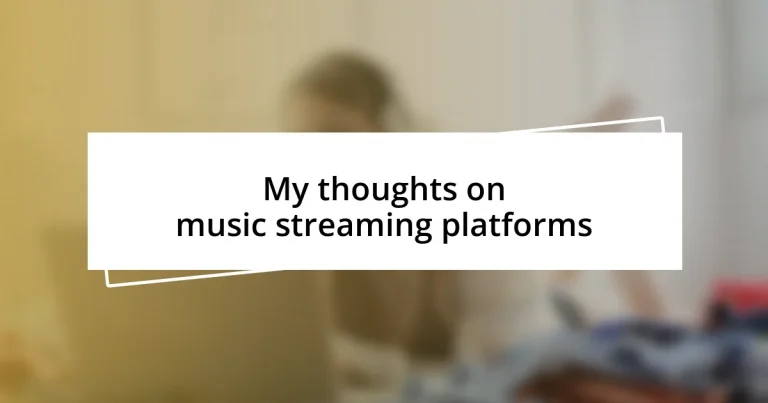Key takeaways:
- Music streaming platforms have reshaped music consumption, offering instant access to a vast array of songs while raising concerns about artist compensation and the nostalgia of physical ownership.
- Personalization and social features in platforms like Spotify and Apple Music enhance user experience, allowing for tailored playlists and communal music discovery.
- The future of music streaming may include augmented reality experiences, deeper social media integration, and the influence of artificial intelligence on music creation, presenting both opportunities and challenges for the music industry.
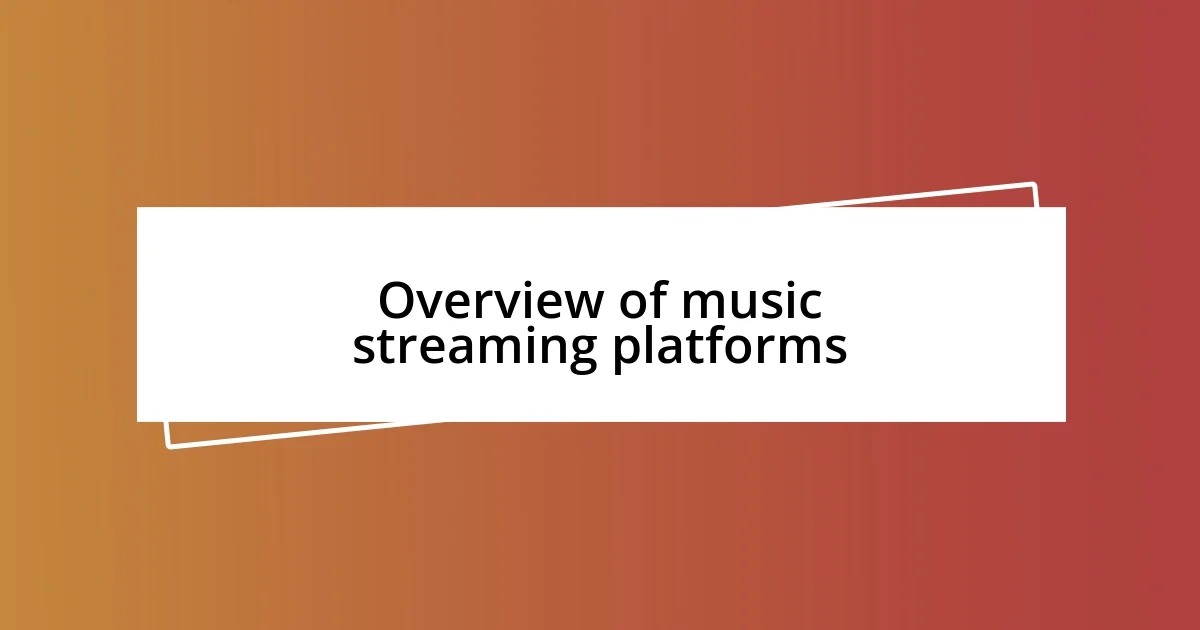
Overview of music streaming platforms
Music streaming platforms have fundamentally transformed how we consume music today. Reflecting on my own experiences, I remember the thrill of discovering an entire world of artists at my fingertips, shifting from buying CDs to playlist binging. Doesn’t it feel liberating to access thousands of songs instantly, wherever you are?
Each platform, like Spotify, Apple Music, or Tidal, offers unique features that cater to different preferences. For instance, I often find myself lost in curated playlists tailored to my mood or activity. It’s almost like having a personal DJ who knows my taste better than I do. How cool is that?
However, the convenience of streaming comes with its own set of challenges, like artist compensation and music discovery. It raises the question: Are we trading in music ownership for convenience? Personally, I feel a bit torn; while I enjoy the immediate accessibility, it sometimes makes me nostalgic for the days of physically owning albums and savoring the artwork.
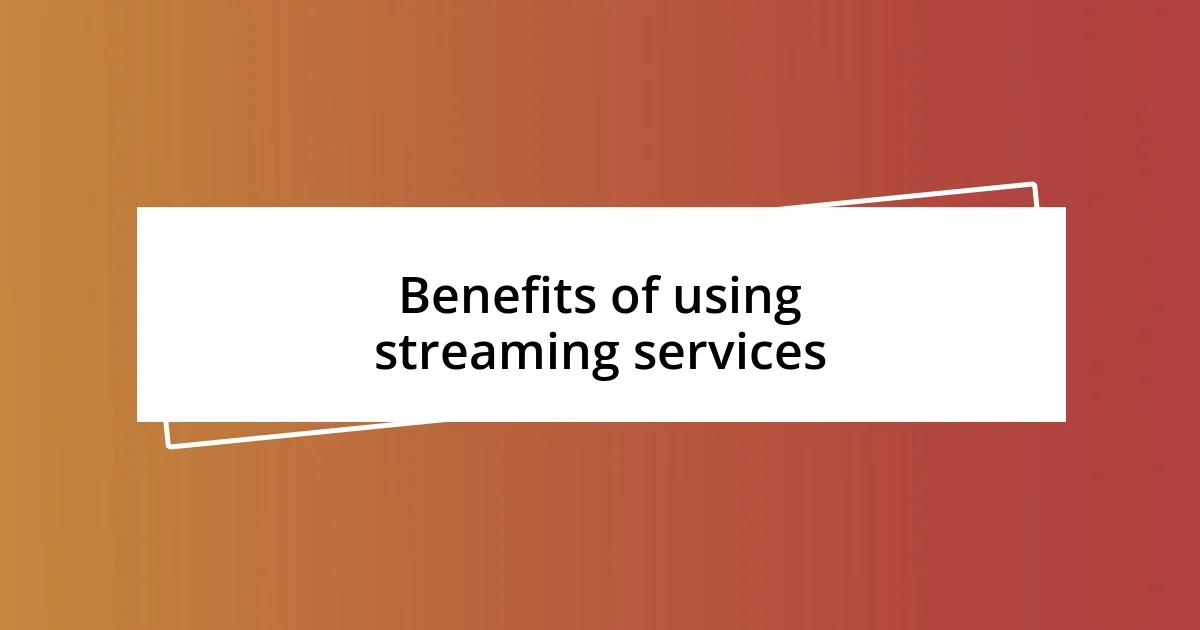
Benefits of using streaming services
One of the most significant benefits of using streaming services is the sheer diversity of music available. I remember the excitement of stumbling across an underground artist or a genre I had never explored before, all thanks to the endless recommendations these platforms provide. It’s like venturing on a musical journey where every turn reveals something new and exciting.
- Instant access to millions of songs
- Ability to discover new artists and genres
- Curated playlists based on mood or activity
- Offline listening options for on-the-go enjoyment
- Cost-effective compared to purchasing individual albums
Another aspect I truly appreciate is the personalized experience created through algorithms. It feels almost magical when I log in and see tailored playlists waiting for me. Sometimes, I’m surprised by how accurately these platforms anticipate what I’d love to hear. It’s almost as if they know me better than some of my closest friends do!
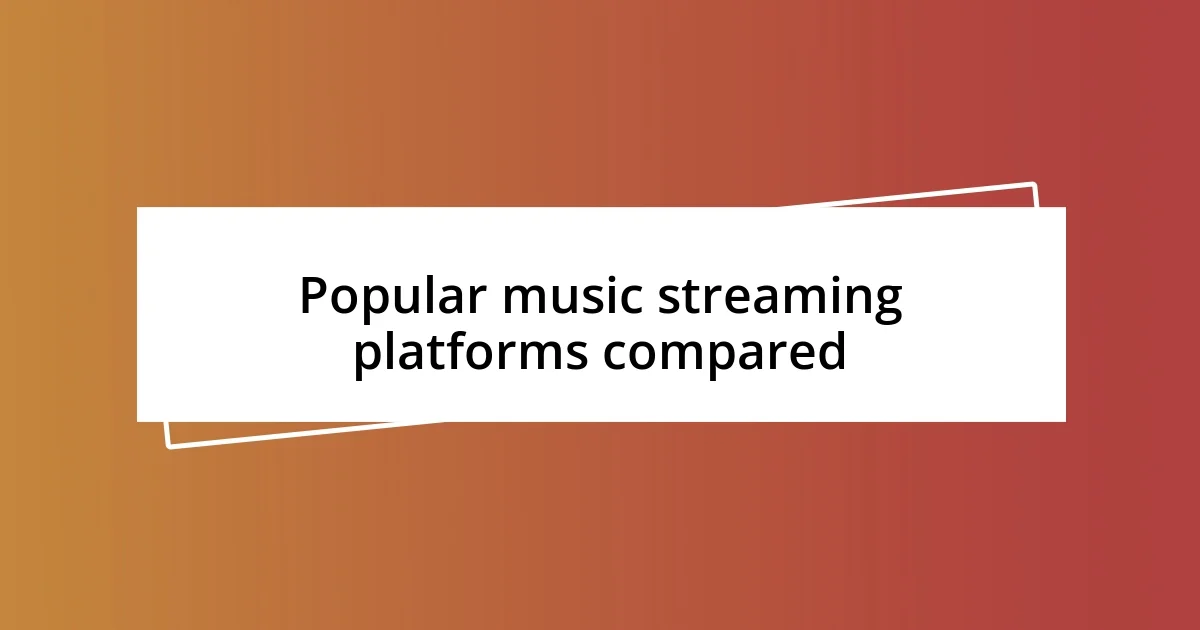
Popular music streaming platforms compared
When comparing popular music streaming platforms, it’s essential to look at their distinct offerings. For example, I’ve found that Spotify excels in its user-friendly interface and extensive library. There’s something comforting about scrolling through endless playlists and discovering new favorites, all while enjoying the social aspect of sharing music with friends. Apple Music, on the other hand, appeals to my taste for high-quality audio and seamless integration with my Apple devices. Their curated playlists often feel like a personal touch, as if a friend has handpicked songs just for me.
The differences extend to pricing models and subscription options as well. I remember when I switched to a family plan; it was a game-changer! With platforms like Tidal, the focus on artist payouts caught my attention. I’ve often wondered if paying a little extra would help support my favorite artists more directly. It poses an interesting consideration on how much value we place on our listening preferences compared to artist compensation.
Here’s a concise comparison of some popular music streaming platforms:
| Platform | Key Features |
|---|---|
| Spotify | User-friendly interface, extensive library, social features |
| Apple Music | High-quality audio, curated playlists, strong device integration |
| Tidal | Focus on artist payouts, high-fidelity audio options |
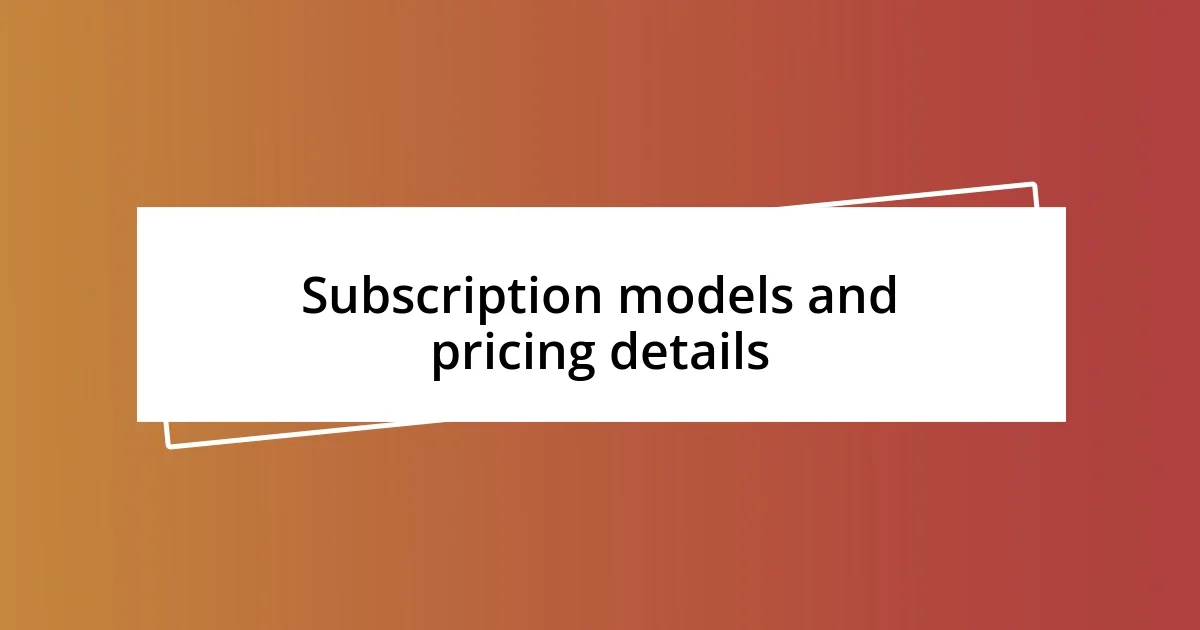
Subscription models and pricing details
When it comes to subscription models, I’ve noticed that most platforms offer tiered plans to cater to different needs. For instance, I remember when I opted for a student discount on Spotify; it felt like a steal for all that music! Most services provide options like family plans, which can be remarkably cost-effective if you’re sharing with loved ones. Have you ever calculated how much you save compared to buying individual songs or albums? It’s eye-opening!
Pricing details can vary widely from one platform to another. I’ve always considered Tidal’s higher subscription fee a double-edged sword. While the promise of better artist compensation is enticing, I often find myself asking: am I really willing to pay more? Apple Music follows close behind with its competitive pricing, but I’ve found myself torn between their features and the appealing social dynamics of Spotify.
Ultimately, the key is to find what resonates most with your listening habits and budget. Personally, I recently shifted back to a basic plan after testing various premium features. It made me realize that sometimes, simplicity offers the best experience. Have you thought about the value you get from your current subscription? It’s worth pondering as you dive deeper into the music streaming world.
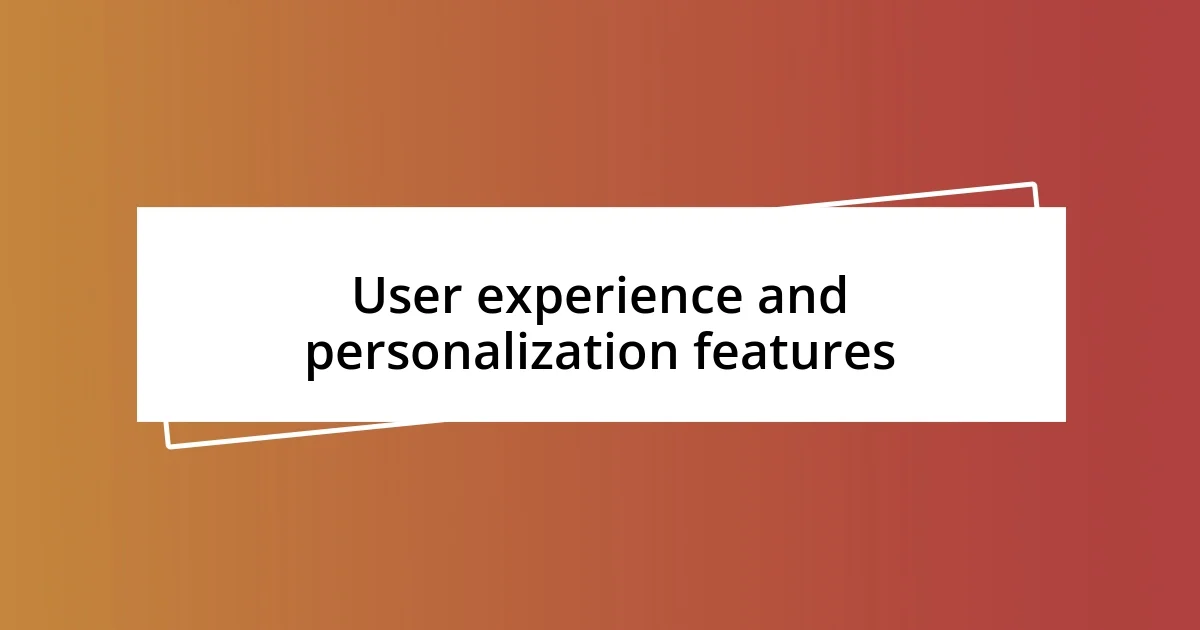
User experience and personalization features
User experience on music streaming platforms can greatly shape our relationship with music. I remember my first encounter with Spotify’s Discover Weekly feature; the excitement of seeing new recommendations felt like a personalized gift each Monday. It’s fascinating how algorithms analyze our listening habits and introduce us to tracks we might have never found on our own. Do you find yourself exploring those recommendations, too?
Personalization isn’t just about song suggestions, though. Take Apple Music’s curated playlists—there’s something intimately satisfying about playlists tailored to my mood or activity. I’ve often felt as if those playlists were created by a close friend who knows my tastes inside and out. Have you ever listened to a carefully curated mix that instantly changed your day? It’s those moments that highlight the power of personalization within streaming experiences.
Then there’s the social aspect, which I truly appreciate. Platforms like Spotify allow me to see what my friends are listening to, fostering connections through music discovery. I can’t recall how many times I’ve attended gatherings where shared playlists became the soundtrack of the night. It makes me wonder: how much do our shared musical experiences enhance our enjoyment of music? These little features add layers to our interactions and deepen our emotional connection to the music we love.
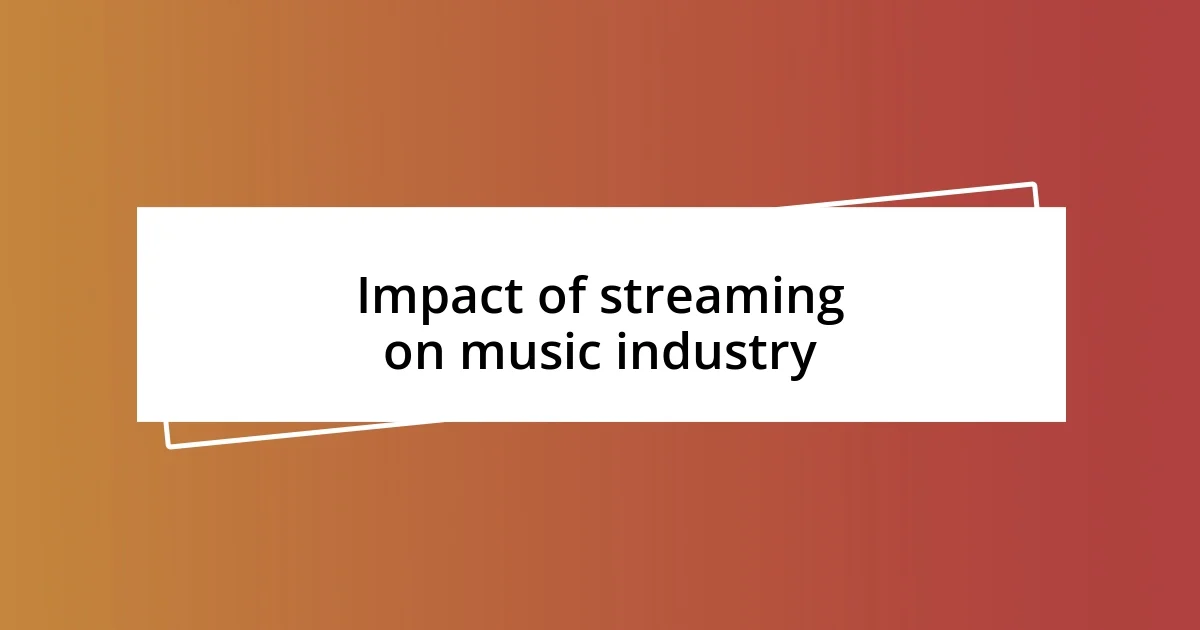
Impact of streaming on music industry
Streaming has profoundly reshaped the music industry in both positive and challenging ways. From my experience, the rise of platforms like Spotify and Apple Music has led to an explosion in music accessibility. I recall the thrill of discovering an indie band that, before streaming, I might never have come across. This accessibility has democratized music distribution, allowing countless artists to find their audience. But have you wondered how this affects traditional sales models? Many artists struggle as album sales plummet, leaving them to adapt to a new reality where concerts and merchandise become vital revenue streams.
Moreover, the compensation model for artists has sparked heated debates within the industry. It pains me to think about how much smaller the payouts can be compared to physical album sales. I remember reading about an emerging artist who mentioned that they needed millions of streams just to earn a fraction of what they might get from a single album sale. This got me thinking: is the current streaming ecosystem sustainable for creators? It’s troubling to see how the success of a song is measured more by algorithms than by the artistry involved.
On the flip side, the rise of streaming has encouraged creative experimentation. I often find myself enthralled by how artists release singles and EPs rather than sticking to traditional album formats. This shift reflects the industry’s adaptation to listener habits. But does this fast-paced approach compromise the depth of their artistry? I’ve found that while I enjoy the instant gratification of new music, there’s something special about an album crafted as a cohesive experience. Balancing instant access with meaningful artistry remains one of the most fascinating challenges in our digital music landscape.
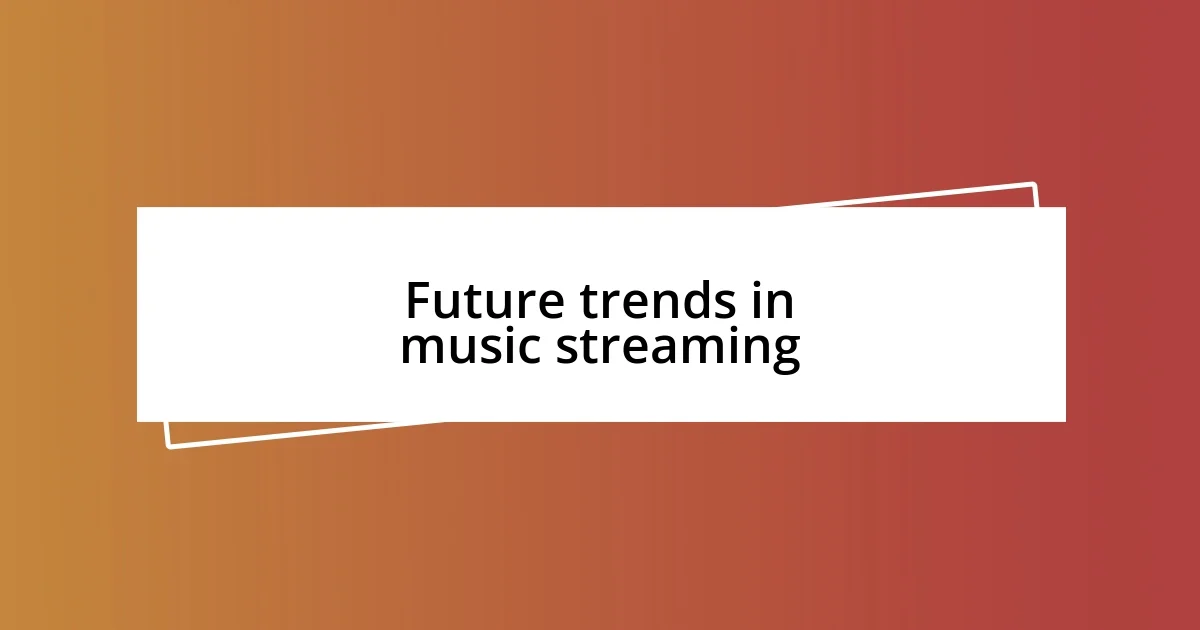
Future trends in music streaming
As I look towards the future of music streaming, I can’t help but feel excited about the potential for immersive experiences. Imagine listening to your favorite songs not just through your earbuds, but surrounded by an augmented reality (AR) environment. I’ve had the chance to try some early AR music experiences, and I was amazed at how they enhanced the listening experience. Have you ever thought about how technology could transform the way we engage with music? It feels like we’re on the brink of something extraordinary.
Another trend I foresee is the deepening integration of social media with music streaming services. A few months ago, a friend shared a clip of an artist’s live stream on a platform I didn’t even consider for music. That connection made me feel like part of a community. Streaming platforms can leverage this by allowing users to host virtual listening parties or collaborate on playlists in real-time. I wonder how that could elevate the communal feel of music listening. Will it make us feel more connected to each other and to the artists we love?
Lastly, I’ve often contemplated the growing role of artificial intelligence in music creation. There are already AI tools that help musicians compose tracks or even generate lyrics. I once dabbled with an AI music generation app, and while it was fascinating, I also found myself longing for the human touch in music. How do we preserve the essence of artistry while embracing technological advancements? Striking a balance between innovation and authenticity is crucial as we move forward, and I’m curious to see how this will shape our musical landscape.












